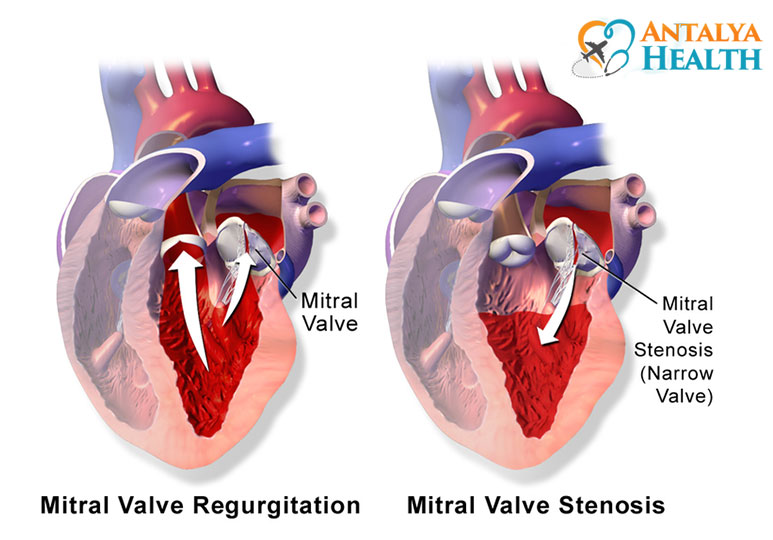Mitral Valve Surgery
Mitral Valves are the valves that regulate blood flow according to the pumping properties of the heart by placing it between the chambers of the heart or between the heart chambers and the main veins. There are four valves in the heart. On the left side of the heart where clean blood loaded with oxygen is pumped into the body, aortic and mitral caps are pumped into the lung.Trikuspid and pulmonary valves are found on the right side of dirty blood pumped into the lung.
Surgical Valve Diseasese and Treatments
Heart valve diseases account for 1-2% of all deaths in the world. In recent years, effective and permanent surgical treatment opportunities have been developed in heart valve surgeries thanks to rapid advances in artificial valve technology.
Pathologies that prevent or create inability to prevent or hold the blood require surgical correction after a certain stage, where the valves allow blood passage.
The disease can be on a single valve, or multiple valves may have been affected at the same time. In this case, the disease usually begins on one valve and then disrupts other covers as per the principles of the working of the heart. The main causes of heart valve disorders; congenital disorders, rheumatic fever, infections, deterioration of old age, coronary heart disease and aortic aneurysm. When valve diseases reached the surgical stage, they often created both stenosis (stenosis) and insufficiency.
Stenosis (stenosis): Pathology that prevents sufficient passage of blood in cases where fiberlets thicken, deform or stick together. Cordaes may have been affected at the same time. If the amount of blood passing goes below a critical level, it is necessary to undertake surgery.
Mitral Insufficiency : As a result of expansion in the anuler tissue, deformation in fiberlets or elongation in the corsets, the closure of the lid cannot be fully realized and some blood escapes. The amount of blood that runs backwards requires surgical intervention when it exceeds in a critical level.
Mitral Valve Stenosis (Stenosis) Causes
- It most often occurs due to rheumatic heart disease (such as joint rheumatism, etc.)
- Serious mitral annuities
- Congenital mytral valve anomalies (distorted)
- Endocarditis (Valve infection)
- Left atrial thrombosis, tumor in left atrium
- Metabolic and carcinoid syndromes that lead to deformation
- Undergo complications (undergo mitral valve surgery)
- Spent mitral valve replacement (valve replacement)

Causes of Mitral Valve Failure
- Mysomatosis degeneration of the mitral valve (disorder of cartilage tissue)
- Rheumatic heart disease (such as joint rheumatism)
- Infected endocarditis (valve infection)
- Mitral anulus calcification (calcification)
- Idiopathic (unspecified cause) corda rupture
- Ischemic (due to coronary insequality)
Symptoms in Mitral Valve Diseases
Shortness of breath, palpitations, arrhythmia, chest pain, fainting, swelling of the legs, bloody sputum spitting, a sign of heart valve disease that can’t spread on the back. A few of these symptoms are usually found at the same time. The appearance of symptoms in heart valve diseases is important in the surgical decision stage.
Mitral Valve Surgery
Although mitral valve surgeries are very varied, they are divided into 2 in the general classification:
- Replacement (Replacement)
- Reconstruction (Repair)
Mitral Valve Replacement : This is a process of removing the diseased valve completely and replacing it with mechanical or biological prosthesis caps.No matter how high the mechanical valve is, it is absolutely mandatory to use postoperative blood thinner spraying drugs such as Coumadin (Warfarin). Mechanical valves operate smoothly for years as a result of optimal adjustment of blood thinners.
Mitral Valve Repair : If the cartilage structure of the mitral valve leafs is not very intact, if it is not calcified, or if there is a leakage only due to the growth of the heart, it may be suitable for repair. Repair is the most appropriate surgical method due to its advantages to the patient. After valve repairs, patients do not use blood thinners, the risk of bleeding, clotting (Embolism) or valve infection is almost zero.
Both Mitral Valve Repair and Mitral Valve Replacement
(Replacement) can be performed with small incisions. Techniques mentioned above can be applied with a 5 cm incision usually made from the right chest.
Mitral Valve Surgery success rate varies between 97% and 99%.
If you want you can reach us via Whatsapp. Our Number: +90 544 766 30 30
